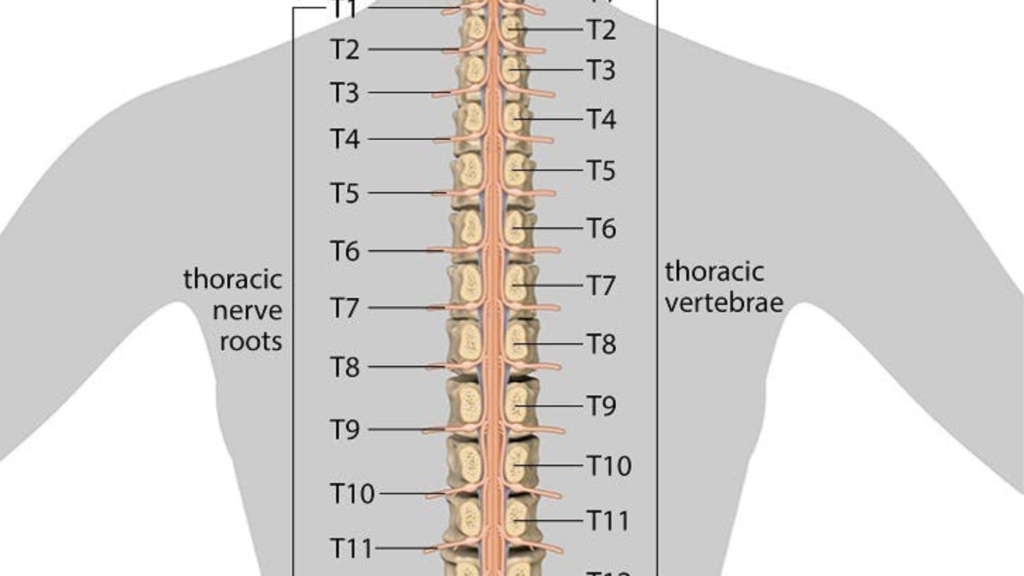Your upper and middle back area is less prone to trouble than your lower back. That’s because it doesn’t bear as much of the load of your body’s weight and work as your lower back does.
But this area, which runs from the base of your neck to the bottom of your rib cage, can still be a source of pain.
Your Back’s Structure
You have 12 vertebrae in your upper and middle back.
Between the vertebrae are spongy discs. You might think of them as shock absorbers for your body. They cushion the bones when you move around. Ligaments and muscles hold the spine together. The entire area is called the thoracic spine.
It works with your ribs to keep your body stable and protect vital organs such as your heart and lungs.

Symptoms
Pain in your upper and middle back may be described as:
- Aching
- Stiffness
- Sharp
- Burning
Causes
Poor Posture:
One of the leading culprits behind middle and upper back pain is poor posture. Prolonged periods of slouching, hunching over desks or electronic devices, or carrying heavy backpacks can strain the muscles and ligaments in the back, leading to discomfort and pain. Maintaining good posture and taking regular breaks to stretch can help alleviate and prevent such pain.
Muscular Imbalances:
Muscular imbalances occur when certain muscles become stronger or tighter than others, disrupting the natural alignment of the spine. Weak abdominal muscles, for example, can lead to increased strain on the back muscles, resulting in pain. Regular exercise, including strength training and core exercises, can help restore balance and reduce back pain caused by muscular imbalances.
Sedentary Lifestyle:
A sedentary lifestyle, characterized by prolonged periods of sitting or inactivity, can contribute to middle and upper back pain. Insufficient physical activity weakens the muscles supporting the spine, making them more prone to discomfort. Incorporating regular exercise, such as walking, swimming, or yoga, into your routine can improve back strength, flexibility, and overall spinal health.
Injury and Overuse:
Back pain can also be the result of injury or overuse. Engaging in activities that involve repetitive motions, lifting heavy objects incorrectly, or sudden twisting movements can strain the back muscles, leading to pain. It is important to use proper lifting techniques, take frequent breaks during repetitive tasks, and gradually increase the intensity of physical activities to minimize the risk of injury.
Herniated Discs:
Herniated discs, also known as slipped discs or ruptured discs, can cause significant back pain. These occur when the cushion-like discs between the vertebrae in the spine rupture or bulge, putting pressure on the surrounding nerves. This condition can result from wear and tear or sudden trauma. Treatment options may include rest, physical therapy, pain management techniques, or, in severe cases, surgery.
Stress and Emotional Factors:
Believe it or not, emotional and psychological factors can contribute to middle and upper back pain. Stress and anxiety can cause muscle tension and tightness, leading to discomfort. Incorporating stress management techniques, such as meditation, deep breathing exercises, and engaging in activities that promote relaxation, can help alleviate back pain associated with emotional factors.
Medical Conditions:
In some cases, middle and upper back pain may be symptomatic of an underlying medical condition. Conditions like osteoarthritis, fibromyalgia, spinal stenosis, or scoliosis can cause chronic back pain. If you experience persistent or worsening pain, it is essential to consult a healthcare professional for an accurate diagnosis and appropriate treatment options.
Patient presenting with shoulder pain and upper back pain
Always consult your physiotherapist for a proper assessment and evaluation.
Interested in learning more about this treatment- feel free to reach out at don@donkellypainrelief.com or you can give me a ring 089 273 4307
My treatment plan is the result of my experience and knowledge in treating chronic pains and injuries over the last 20 years. This is the holistic plan to guarantee pain relief, prevent recurring pains, and faster recovery.
EVALUATION/ASSESSMENT
PHYSIOTHERAPY PLAN BASED ON MY ASSESSMENT
HOMECARE EXERCISE/PLAN
ACUPUNCTURE
EXERCISE PROGRAMME
DRY CUPPING/DRY NEEDLING
MASSAGE


